Hey, remember the Big Bang? Y’know, creation of the known universe and all that. Game changer.
There have been smaller versions of that, too, ever since that big Big Bang. Events that changed the course of life as we know it. The invention of the internet was a pretty big one. The invention of wheels. The invention of yogurt-covered pretzels.
And of course, the invention of artificial intelligence. AI is totally reshaping how we work, how we create, how we communicate—and it’s getting more and more accessible each day. ChatGPT, anyone?
That’s true for marketers, too. Businesses are adopting AI marketing tools to help them get better results from their campaigns—often with less effort and lower costs. We even did a little research of our own and it turns out, more than 80% of businesses believe AI tools will positively impact their business in three years or less. Businesses—and not just the ones running tech startups out of Silicon Valley—are hungry for a piece of that AI pie.
Some marketers are already using AI to create more customized campaigns. Some are still skeptical that AI can deliver results as good (or better than) a real, live person. But one thing’s certain: AI marketing is happening, and even if you’re not gonna adopt AI tools, you need to know what it’s all about.
So, what does AI marketing really even mean? Let’s take a deep dive.
Here’s what you need to know about AI marketing:
What is AI marketing?
Before we can talk about AI marketing, we need to start by goin’ back to basics. What is artificial intelligence?
Artificial intelligence is just a way of talking about computers that canthink—or appear to think—like humans. A brilliant ol’ fella named Alan Turing first proposed the question, “Can machines think?” The answer depends on who you ask (and what we agree “thinking” even means), but it’s generally accepted that machines today can successfully replicate human intelligence in some circumstances.
AI is all about programming computers to perform tasks that normally require a person, like recognizing speech, making decisions, and even learning from experience. If that thought freaks you out, instead imagine having a cute lil robot brain inside your computer, ready to help you out with whatever task you throw its way. Adorable.
AI marketing is just the application of AI for marketing purposes. Marketers in this day and age are using the power of AI to speed up (or even automate) content creation, analyze customer data for insights, respond to support requests—all sorts of things that would normally take time and expertise. Frickin’ cool, right?
Examples of AI in marketing
Maybe this all sounds a little abstract—but marketers are using AI and getting real, concrete results. Here are some examples of what that looks like:
AI offers tons of benefits to marketers. It doesn’t just get you better results—it also speeds up mundane tasks, reduces the need for additional headcount, and lets you focus on the big picture. Many marketers are adopting AI tools—like copy generators, design assistants, and marketing automation and optimization software—because they help ‘em save money, fill expertise gaps, and free up more time. Show us a marketer who doesn’t want literally all of those things?
Popular types of AI marketing
AI is everywhere. It’s like the sand you find all over your house after that one day playing volleyball at the beach. (Top Gun just made it look so darn fun.)
Many industries have adopted AI or are in the process, and it’s no different for marketing. So, what types of AI are available for marketers, and how are they used?
AI data analysis
To succeed in marketing, you gotta know what makes your customers tick. AI can crunch the numbers for you and analyze all youe juicy data to understand consumer habits. From there, it can predict what products and services they’re likely to buy based on their online history and past purchases. With this intel, marketers can forecast sales, manage inventory, and push the right products to the right people.
It’s like having an octopus that can predict the future, but without that… fishy smell.
AI content generation
AI can help marketers create all sorts of content for social media, email marketing (hello, subject lines), and other communication channels. Marketers can set parameters around the generated content and ultimately have the final say in what gets sent or published.
For example, we’ve got an AI copywriting tool to help users write engaging content for landing pages, emails, and ads. Spin up some content, keep what you like, and bin the rest. (Also, check out our guide to AI writing and how it can improve your content.)
Though AI can’t replicate human creativity, it can save your team time—and maybe even fuel a bit of inspiration.
Dynamic pricing AI
The retail world’s version of “now you see it, now you don’t!” Dynamic pricing is when prices change based on things like traffic volume or product availability. You know the drill: You search for something, leave it for a bit, and when you come back, the price has gone through the roof. (Not nice, ecommerce website.) Of course, the theory is that prices then drop once demand ebbs.
For marketers, AI-powered dynamic pricing is gold. They can create campaigns that create a sense of urgency and maximize their ROI, without needing to adjust prices themselves manually. It’s a win-win situation. (Except when you have to pay through the nose for that flight to your cousin’s wedding.)
AI chatbots
Chatbots have become a common feature of the customer service experience. Think about the little chat bubble embedded on many websites, or the responses you get from brands on social media, by email, or by text. AI chatbots can be used to assist customers with various tasks, like placing orders or even working through technical hiccups. (Thanks again, “Brad,” for wishing me a happy birthday while fixing my phone service issue.)
Chatbots also have the potential to generate new sales opportunities. AI chatbots can make more personalized recommendations by collecting data about a customer’s interests and preferences. For marketers, that means more conversions. Good stuff.
AI conversion rate optimization
Forget about manual A/B testing. Marketers can use AI to automatically select the best version of your content—or better yet, eliminate the need to choose a “champion” entirely. Imagine using AI to quickly spin up dozens of ad or email variants, then letting the machine analyze demographic data to figure out which is likely to perform best for each individual.
For example, Unbounce has got an AI conversion optimization tool for landing pages. Rather than split-testing a couple of variants at a time, marketers can create as many landing pages as they want, then let AI automatically send visitors to the top-converting page for people like them. On average, it gets marketers get 30% more conversions. Just sayin’.
Problems with AI in marketing
Of course, it’s not all sunshine and algorithmically-generated daisies. AI is changing the marketing landscape stupidly fast, and it’s important to also recognize some of the risks that come with this dramatic shift in the way we work.
For example, AI isn’t so great at replicating the emotional intelligence of marketers. Customers still value a human touch, and if their entire experience with your brand is jumpin’ from one artificial experience to the next, it could be a turn off. It’s crucial that marketers don’t let AI replace genuine interaction and connection with their customers.
Likewise, AI lacks human creativity. Generative AI models are incredible for their ability to churn out an absolutely bonkers amount of… well, pretty decent written and visual content. (After all, they were trained on the whole gosh-dang Internet.) But AI doesn’t yet come up with truly original ideas. It just combines other ideas it’s seen before into something that looks kinda new. Marketers can use these tools to accelerate their creative processes, but it you wanna make something great, you’re better off putting in the time to do in the ol’ fashioned way: Thinking of it yourself.
There are other problems with AI, like privacy and data collection. When you share data with an AI tool, you need to be aware of how that data is gonna be used. Imagine you turn over your customer list (with names, emails, phone numbers) for AI analysis. Can you say confidently that the data isn’t gonna be used to train the model, or even show up as generated content for other users?
And we can take that concern a step further. What says an AI tool is even correct?
AI is only as good as the human-created content it’s trained on, and as a species, we’re, uh… we’re not super reliable. If AI is using inaccurate data and biased information to determine its own outputs, then those outputs are inevitably gonna be inaccurate and biased, too.
It’s impossible for a marketer to fact-check the oceans of data informing the AI tools they use. The solution, then, is to always filter what you’re getting from AI through your own skepticism and expertise.
Will marketers be replaced by AI?
It’s true that AI marketing comes with a bunch of great perks. But we’re sure most marketers have woken in a cold sweat with an intrusive thought: Are robots gonna replace me? If AI is just so good at this whole marketing thing, what are we gonna need marketers for?
There’s no denying that digital marketing as we know it is in for some big changes. But marketers—being their usual, nimble selves— are already adapting. Our research shows that marketers are fully aware of how AI can help them juggle everyday challenges, supporting and enhancing their marketing efforts. And as of 2022, 31% of marketers were already using AI to improve their bottom line.
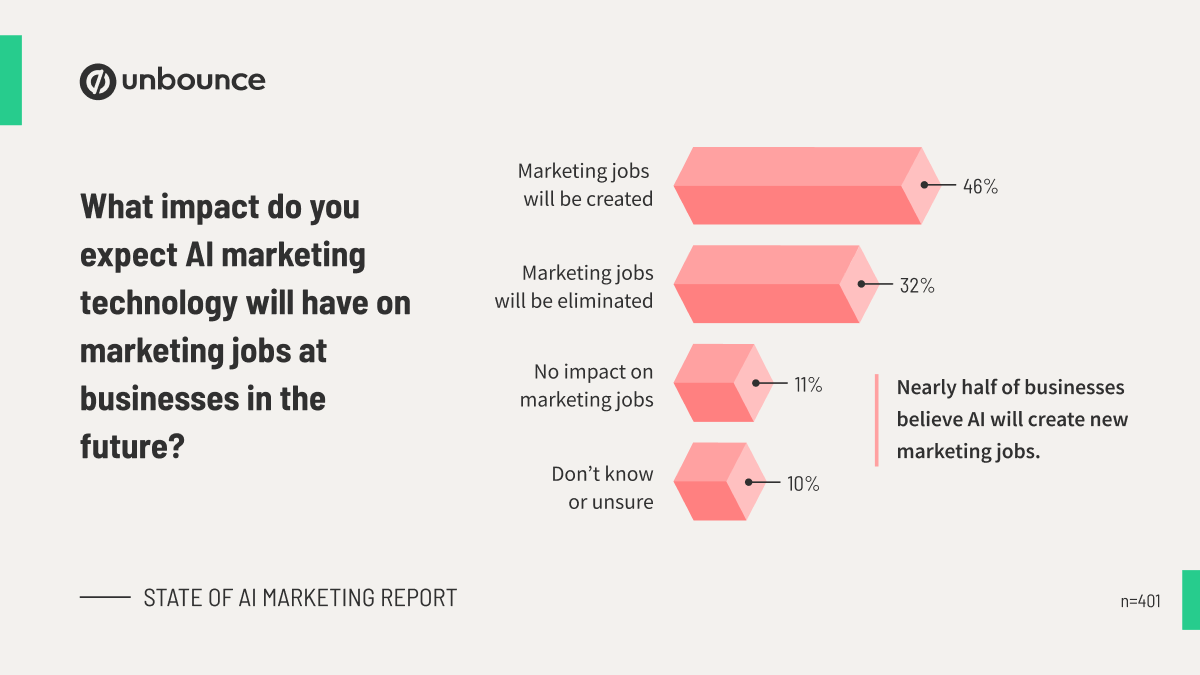
With so many everyday marketing tools integrating AI into the mix (think Notion or Canva), the days of marketers using AI without even knowing it are pretty close. So don’t worry so much about AI replacing you. Instead, worry about the other marketers using AI to level up their skills and increasing their impact. (Now that’s nightmare fuel.)
How to adopt AI in your marketing strategy
At this point, you’re probably thinking about adding some AI to your marketing strategy. Go, you!
While it’s not a magical solution that can solve all your problems, AI can give your marketing efforts that boost you’re lookin’ for. It won’t replace your entire marketing team, but it can automate tasks, improve conversion rates, and help you identify new opportunities to engage with your audience.
But before jumping in headfirst, here are some things to consider:
Evaluate your existing processes
If you’re considering adopting an AI tool, first think about how it’ll fit into your current workflows. That means deep divin’ into your audience, understanding their journey and potential pain points, and identifying areas where AI can help you create a better experience.
Let’s say you run an online clothing store. You could start by (manually) analyzing some of your existing customer data to identify patterns and trends. What are the most popular clothing items that are flyin’ off your shelves? What are the most common reasons you get for returns? What are the most asked questions by your customers?
This will help you identify how AI can best be used to improve customer experience, such as personalized clothing recommendations (you can match this top with this skirt), automated returns processing, and chatbots to answer customer inquiries.
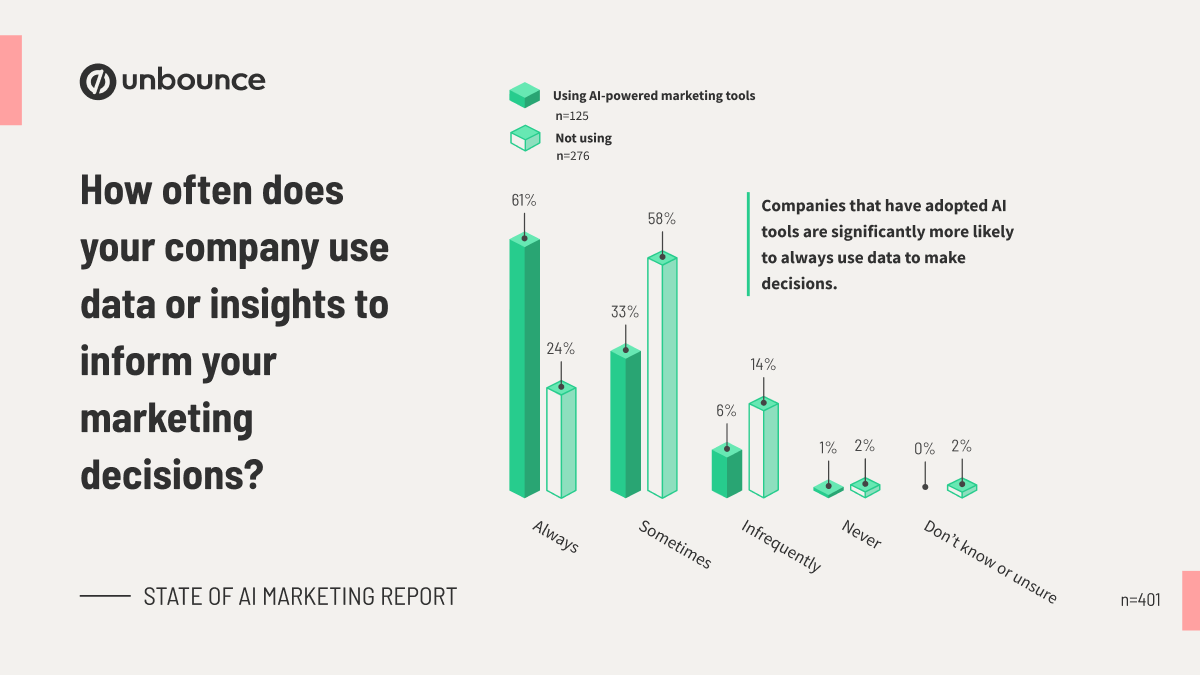
Think about your gaps or inefficiencies
What are some of the frustrations you have with the processes of your team? Think about this in terms of actual manual labor. Think about what things could be slowing you and your team down, and decide where and when to get AI to do some heavy liftin’. It’s all about streamlining your marketing processes.
Let’s say you work for a marketing agency that specializes in social media management for small businesses. You and your team spend a heck of a lot of time manually scheduling social media posts, creating content calendars, and analyzing engagement metrics. Blegh.
You can use AI to tackle some of that manual work. Scheduling posts in advance, optimizing times for maximum engagement, and even creating content based on audience preferences. With all this work outta the way, your team could focus on other tasks that require human creativity. You’d be increasing efficiency and productivity, benefiting your clients and their social media presence—and gettin’ more business as a result.
Plan how you’ll implement new tech
Implementing any new technology into a team’s marketing processes can take lotsa time and effort. To get the most out of AI-powered tools, you’ve gotta know how to use ‘em efficiently so your team (and your customers) can get the best experience.
Imagine you’re the marketing director for an ecommerce company that sells consumer electronics. You’ve decided to implement an AI-powered chatbot on your website to handle customer inquiries and provide personalized product recommendations. Smart.
But implementing this technology into your team’s workflow means real time and effort. To get the most out of the chatbot, you’ll need to train it with accurate data, program it with relevant scripts, and integrate it seamlessly into your website. Not to mention training your team on how to use the chatbot—how to monitor conversations, escalate issues to human support, and analyze chat logs for insights.
Be sure you’ve got a plan for how you’ll implement AI tools before you pay for ’em.
Trends and the future of AI marketing
Artificial intelligence ain’t sci-fi anymore. The past few years have seen huge advances in AI tech. Crystal ball in hand, here are some trends we’re expectin’ to see in the future.
- Concerns about privacy and security will increase. Despite all these great things happenin’ with AI, the trust issues are still there. Consumers are legit scared of their data being collected and used against them. That means marketers gotta start addressing privacy concerns by providing more transparency around the data they’re collecting, and using it only to the benefit of the customer. It’s also time for organizations to beef up their cybersecurity game—because hackers are starting to use AI, too. Businesses will need to take additional steps to protect their customers’ data from algorithmically-augmented outlaws.
- Voice-enabled AI is (still) gonna change marketing. Voice-enabled AI has been the talk ‘o the town for years now. At this point, some of us talk to assistants like Siri and Google Home more than actual people. Still, this conversational AI remains under-utilized in marketing. That’s gonna change. In the not-so-distant future, marketers will need to consider speech recognition technologies in their marketing strategies. In fact, voice-recognition tech was already projected to become a key business channel in 2022. Who needs fingers when you’ve got a voice assistant?
- AI will keep getting better at generating creative work. AI in marketing is getting smarter by the minute. With more marketers jumping on the AI marketing bandwagon, AI itself is learning all sorts of algorithms and refining its content like a pro. The best part? The more data it collects, the more impressive its outputs become. That means we can expect to see some seriously impressive content generated by AI—we’re talkin’ copy, images, videos, and basically any other medium you can think of.
Marketers: It’s time to join forces with AI
AI is the new hotness, and it’s shakin’ things up in the world of marketing. But don’t worry—it’s not here to steal your job. In fact, by combining your marketing expertise with the power of artificial intelligence, you can become more impactful than ever before. Marketers who adopt AI are more effective than those who don’t—because it saves ’em time, helps them with complex tasks, and boosts the results they get from their campaigns.
Likewise, AI works best when it’s paired with a real person. It needs you—to check that the information it provides is accurate, to improve the written and visual content it creates, to keep it from rising up against its human overlords in a Terminator-type machine revolution. Rather than feeling threatened by AI, marketers need to recognize the value that both sides bring to the partnership—and start kickin’ butt and crushin’ conversions together.

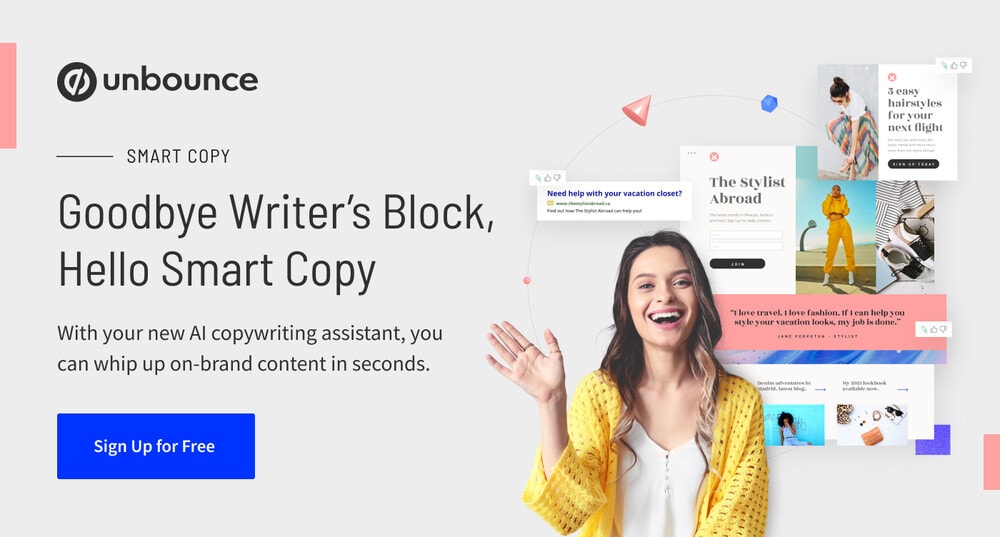
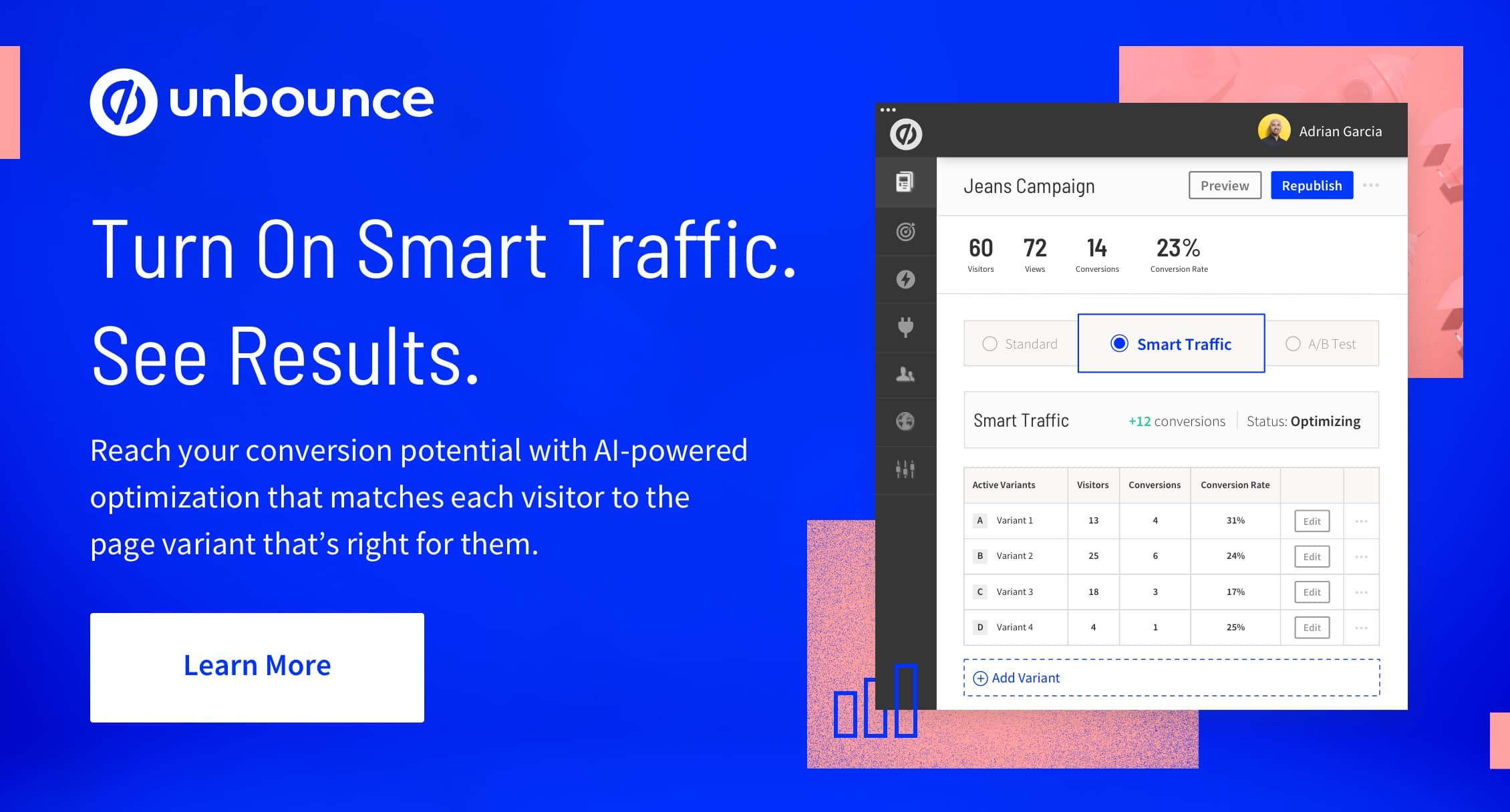
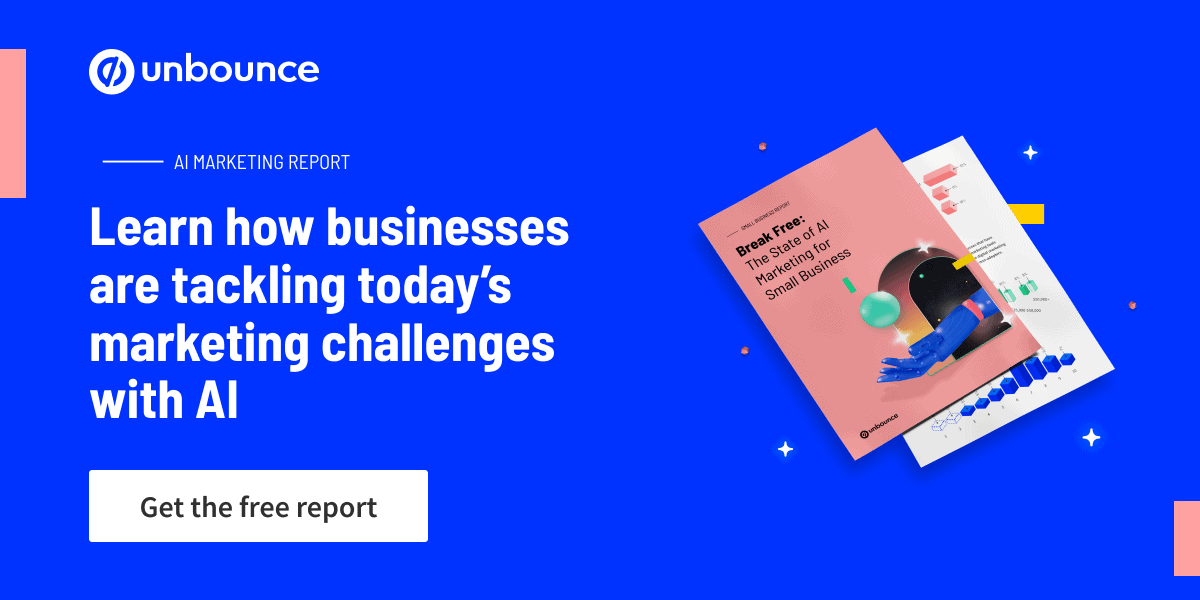


![How to Optimize for Google’s Featured Snippets [Updated for 2024]](https://moz.com/images/blog/Blog-OG-images/How-to-Optimize-for-Googles-Featured-Snippets-OG-Image.png?w=1200&h=630&q=82&auto=format&fit=crop&dm=1724004002&s=13df73104762982790dab6dc8328023f)


